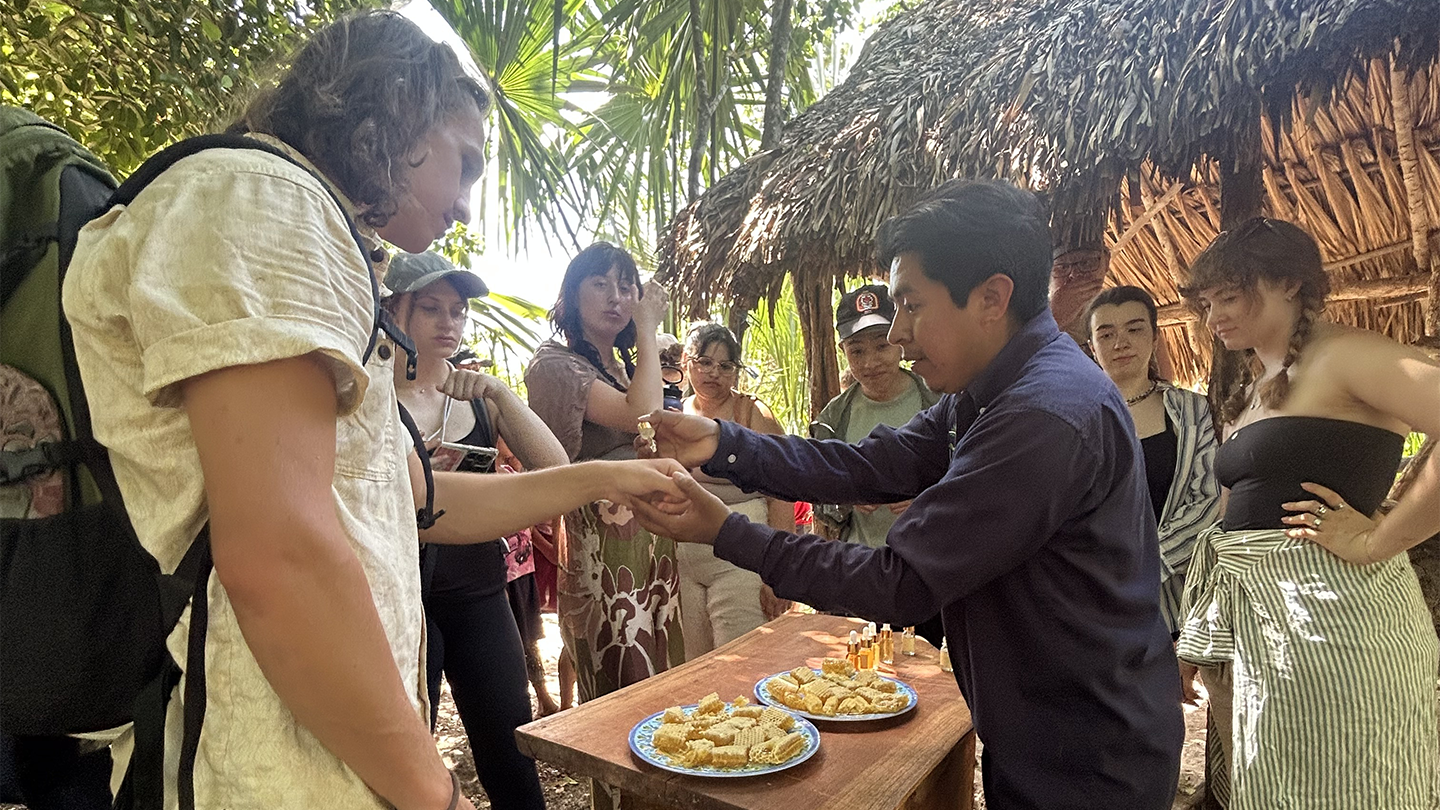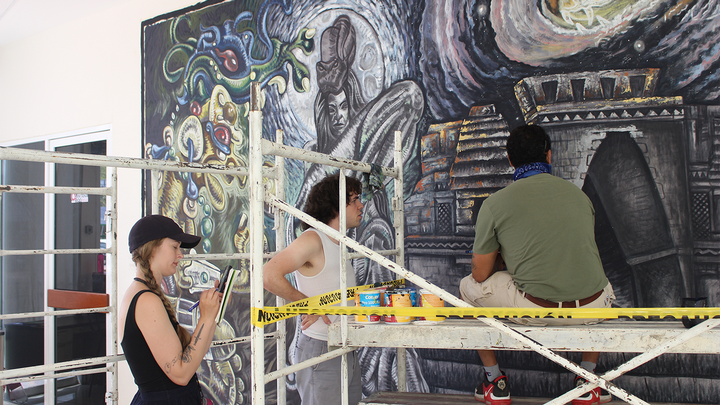Murals and stingless bees, field school
September 11, 2025

Maya stingless beekeeping, street art, and medicinal plant knowledge sharing are part of an Indigenous-centered field school between UVic anthropology and the Office of Global Engagement in partnership with the Maya Intercultural University of Quintana Roo (UIMQRoo).
Led by UVic anthropologist, Mélissa Gauthier and UIMQRoo professor, Juan Castillo Cocom the group of 19 UVic anthropology students arrived in time for “World Bee Day” (May 20) in the heart of the Yucatán peninsula. The day started with an introduction to the local cooperative U Kaabilo’ob X-Cabil (The Bees of X-Cabil) to learn about the Melipona bee and the practice of Meliponiculture.
“Wearing beekeeper suits, we braved the extreme Yucatan heat and humidity to interact with a native bee species; using smoke to calm the bees, we learned about bee husbandry and sustainable practices,” says Alex Lee, anthropology student.
The melipona beecheii, also known as Xunan Kaab in Maya, is a native stingless bee that plays a vital role in safeguarding the peninsula's biodiversity.
Unlike European honeybees, melipona only produce about one liter of honey per year per hive. Instead of being used as a sweetener, Melipona honey is valued for its medicinal properties and cultural significance.
The small community of X-Cabil is a leader in the emerging phenomenon of bee tourism as an avenue for sustainable tourism development in rural areas.
“There is a complex interplay between Indigenous knowledge and scientific research in ongoing efforts to revitalize stingless beekeeping in the Yucatán peninsula,” says Gauthier.
The area is known locally as “la Zona Maya”, or Maya territory. The UIMQRoo is among a network of a dozen higher education institutions in Mexico offering an Indigenous-centred curriculum and bilingual Spanish / Maya education with multiple opportunities for English study as well.
A workshop led by Doña Amira Sierra Cautch, a well-respected local herbalist and UIMQRoo students enrolled in the community health program taught UVic students how to make anti-bacterial gel, insect repellent and soap with local medicinal plants fostering meaningful student interactions between the two groups.
"Learning alongside the UIMQRoo students was one of the most meaningful parts of the field school. Making herbal remedies deepened my understanding of traditional knowledge, and reminded me of how much wisdom is held in local practices. I’m very grateful that I was able to have this experience, and gain a window into different ways of knowing,” says Sasha Graham, anthropology student.
Teaching Assistant Edber Dzidz Yam, a PhD student in anthropology at the University of New Mexico and an UIMQRoo alumnus, greatly facilitated the translation of complex Maya concepts related to health and spiritual wellbeing between Maya, Spanish and English.
The students also toured a medicinal plant garden with Don Idelfonso Yah Alcocer, a Maya ritual specialist (J-meen in Maya) from Chacsinkín, Yucatán.
“You must ask permission from the plant,” Yah Alcocer explains. “Only then will its healing abilities work.”
The power of plants lay not only in their physical properties says Yah Alcocer, but also in the respect and faith people brought to them.
"Learning from Indigenous students, researchers and local knowledge holders in an educational setting like the UIMQRoo represents a unique opportunity for UVic students to develop intercultural understanding and a greater appreciation for Indigenous worldviews,” says Gauthier.
Murals bring back colour

During the three-week field school––May 11 to 31––the students experienced art firsthand and connected classroom learning with tours of the city’s murals.
“The abundance of murals on campus and all around the city’s landscape is something that really struck me when I first visited José María Morelos,” says Gauthier.
By bringing students and artists together, Gauthier turned the streets into classrooms–empowering the exploration of identity, culture, and community through public art. As part of their training in ethnographic research, students participated in a digital storytelling project in collaboration with local mural artists.
They learned how to use the digital storytelling platform ArcGIS StoryMaps to create a StoryMap including interviews, images, videos and interactive GIS maps or guided tours of murals found across the city. Students even got the opportunity to observe mural making in progress and ask questions of the artists completing the murals.
Well-known graffiti and street artist Datoer is collaborating with his community in Merida, Yucatan, to bring back colour and culture to a place becoming more populated by tourists and gentrification.
“Datoer took us on a mural tour of his neighbourhood, his art was prominent and captivating, displayed on walls and buildings all over the area and portraying everything from influential figures like Frida Kahlo and Benito Antonio Martínez Ocasio (bad bunny) to popular anime shows and portrayals of local flora and fauna,” says Avery Leake, anthropology student.
The Mexico Ethnographic Field School introduced UVic students to intercultural understandings and Indigenous worldviews, says Gauthier, while also teaching students about socio-economic dynamics that characterize contemporary Maya culture in the Yucatán Peninsula.
For more information: Mexico Ethnographic Field School
